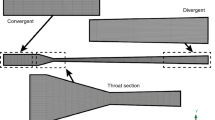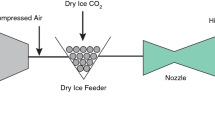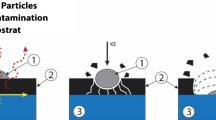Abstract
In this paper, a numerical study was performed to examine the effect of divergent nozzle length of single-hose dry ice blasting on the development of acoustic power level. The active working medium is the mixture of solid dry ice particles and compressible air fluid at the inlet section. The two-dimensional planar model was solved using the finite volume method. The model has been verified theoretically by comparing to four different properties which are pressure ratio, density ratio, temperature ratio, and Mach number ratio over different nozzle area ratios (NARs). The results are presented in the quantitative and qualitative morphological views. The result shows that a more significant value of the NAR gives the highest value of velocity and acoustic power level along the nozzle cavity, of which 560 m s−1 and 146.2 dB, respectively. Besides, turbulence intensity is the most significant influencing factor for the acoustic power level development along the nozzle cavity since the trend of acoustic power level and turbulence intensity are the same. The characteristic of particle gas flow provides a novelty approach to determine the most significant influence factor of the performance and the noise emission.






Similar content being viewed by others
References
Akatsuka J, Hromisin S, Falcone J, McLaughlin DK, Morris PJ, editors. Mean flow measurements in supersonic jets with noise reduction devices. AIAA Scitech 2019 Forum; 2019.
Ishii R, Kawasaki K. Limiting particle streamline in the flow of a gas-particle mixture through an axially symmetric nozzle. Phys Fluids. 1982;25(6):959–66.
Ishii R, Umeda Y, Kawasaki K. Nozzle flows of gas-particle mixtures. Phys Fluids. 1987;30(3):752–60.
Ben-Dor G, Britan A, Elperin T, Igra O, Jiang J. Experimental investigation of the interaction between weak shock waves and granular layers. Exp Fluids. 1997;22(5):432–43.
Di Giacinto M, Sabetta F, Piva R. Crowe C. Discussion: “Two-Way Coupling Effects in Dilute Gas-Particle Flows”. ASME J Fluids Eng. 1982;104:304–11.
Lee J. Gas-particle flow in a venturi: a numerical study. Conf. Gas Borne Part., DA. 1981;129–133.
Hamed A, Mesalhy O, editors. Shock wave attenuation in gas particle flows. In: Proceedings of the 4th international conference on multiphase flow (ICMF 2001), New Orleans, LA; 2001.
Burt JM, Seidel J, Leib SJ, editors. Assessment of mixer-ejector nozzle with thermal acoustic shield for jet noise reduction. AIAA Aviation 2019 Forum; 2019.
Uhlmann E, Hollan R. Blasting with solid carbon dioxide—investigation of thermal and mechanical removal mechanisms. Procedia CIRP. 2015;26:544–7.
Donnelly F, Purcell-Milton F, Framont V, Cleary O, Dunne P, Gun’ko Y. Synthesis of CaCO3 nano-and micro-particles by dry ice carbonation. Chem Commun. 2017;53(49):6657–60.
Sarafraz M, Safaei MR. Diurnal thermal evaluation of an evacuated tube solar collector (ETSC) charged with graphene nanoplatelets-methanol nano-suspension. Renew Energy. 2019;142:364–72.
Goodarzi H, Akbari OA, Sarafraz MM, Karchegani MM, Safaei MR, Shabani S, et al. Numerical simulation of natural convection heat transfer of nanofluid with Cu, MWCNT, and Al2O3 nanoparticles in a cavity with different aspect ratios. J Therm Sci Eng Appl. 2019;11(6):061020. https://doi.org/10.1115/1.4043809.
Sarafraz M, Safaei MR, Tian Z, Goodarzi M, Bandarra Filho EP, Arjomandi M. Thermal assessment of nano-particulate graphene-water/ethylene glycol (WEG 60: 40) nano-suspension in a compact heat exchanger. Energies. 2019;12(10):1929.
Sarafraz M, Tlili I, Abdul Baseer M, Safaei MR. Potential of solar collectors for clean thermal energy production in smart cities using nanofluids: experimental assessment and efficiency improvement. Appl Sci. 2019;9(9):1877.
Sarafraz M, Hormozi F. Pool boiling heat transfer to dilute copper oxide aqueous nanofluids. Int J Therm Sci. 2015;90:224–37.
Nazari S, Ellahi R, Sarafraz M, Safaei MR, Asgari A, Akbari OA. Numerical study on mixed convection of a non-Newtonian nanofluid with porous media in a two lid-driven square cavity. J Therm Anal Calorim. 2019. https://doi.org/10.1007/s10973-019-08841-1.
Raza M, Ellahi R, Sait SM, Sarafraz M, Shadloo M, Waheed I. Enhancement of heat transfer in peristaltic flow in a permeable channel under induced magnetic field using different CNTs. J Therm Anal Calorim. 2019. https://doi.org/10.1007/s10973-019-09097-5.
Salari E, Peyghambarzadeh SM, Sarafraz MM, Hormozi F. Boiling thermal performance of TiO2 aqueous nanofluids as a coolant on a disc copper block. Periodica Polytech Chem Eng. 2016;60(2):106–22.
Ellahi R, Zeeshan A, Shehzad N, Alamri SZ. Structural impact of Kerosene-Al2O3 nanoliquid on MHD Poiseuille flow with variable thermal conductivity: application of cooling process. J Mol Liq. 2018;264:607–15.
Salari E, Peyghambarzadeh S, Sarafraz M, Hormozi F, Nikkhah V. Thermal behavior of aqueous iron oxide nano-fluid as a coolant on a flat disc heater under the pool boiling condition. Heat Mass Transf. 2017;53(1):265–75.
Sarafraz M, Tlili I, Tian Z, Khan AR, Safaei MR. Thermal analysis and thermo-hydraulic characteristics of zirconia–water nanofluid under a convective boiling regime. J Therm Anal Calorim. 2020;139(4):2413–22.
Sarafraz M, Tlili I, Tian Z, Bakouri M, Safaei MR. Smart optimization of a thermosyphon heat pipe for an evacuated tube solar collector using response surface methodology (RSM). Physica A. 2019;534:122146.
Sarafraz M. Experimental investigation on pool boiling heat transfer to formic acid, propanol and 2-butanol pure liquids under the atmospheric pressure. J Appl Fluid Mech (JAFM). 2013;6(1):73–9.
Sarafraz M, Hormozi F, Kamalgharibi M. Sedimentation and convective boiling heat transfer of CuO-water/ethylene glycol nanofluids. Heat Mass Transf. 2014;50(9):1237–49.
Olia H, Torabi M, Bahiraei M, Ahmadi MH, Goodarzi M, Safaei MR. Application of nanofluids in thermal performance enhancement of parabolic trough solar collector: state-of-the-art. Appl Sci. 2019;9(3):463.
Sarafraz M, Peyghambarzadeh S. Experimental study on subcooled flow boiling heat transfer to water–diethylene glycol mixtures as a coolant inside a vertical annulus. Exp Thermal Fluid Sci. 2013;50:154–62.
Choi SU. Nanofluids: from vision to reality through research. J Heat Transf. 2009;131(3):033106.
Sarafraz M, Arjomandi M. Thermal performance analysis of a microchannel heat sink cooling with copper oxide-indium (CuO/In) nano-suspensions at high-temperatures. Appl Therm Eng. 2018;137:700–9.
Abdollahzadeh Jamalabadi MY, Ghasemi M, Alamian R, Wongwises S, Afrand M, Shadloo MS. Modeling of subcooled flow boiling with nanoparticles under the influence of a magnetic field. Symmetry. 2019;11(10):1275.
Sarafraz M, Jafarian M, Arjomandi M, Nathan G. Potential use of liquid metal oxides for chemical looping gasification: a thermodynamic assessment. Appl Energy. 2017;195:702–12.
Shahid A, Huang H, Bhatti MM, Zhang L, Ellahi R. Numerical Investigation on the Swimming of Gyrotactic Microorganisms in Nanofluids through Porous Medium over a Stretched Surface. Mathematics. 2020;8(3):380.
Karimipour A, D’Orazio A, Shadloo MS. The effects of different nano particles of Al2O3 and Ag on the MHD nano fluid flow and heat transfer in a microchannel including slip velocity and temperature jump. Physica E. 2017;86:146–53. https://doi.org/10.1016/j.physe.2016.10.015.
Wen D, Lin G, Vafaei S, Zhang K. Review of nanofluids for heat transfer applications. Particuology. 2009;7(2):141–50.
Peyghambarzadeh S, Sarafraz M, Vaeli N, Ameri E, Vatani A, Jamialahmadi M. Forced convective and subcooled flow boiling heat transfer to pure water and n-heptane in an annular heat exchanger. Ann Nucl Energy. 2013;53:401–10.
Somesaraee MT, Rad EA, Mahpeykar MR. Analytical investigation of simultaneous effects of convergent section heating of Laval nozzle, steam inlet condition, and nozzle geometry on condensation shock. J Therm Anal Calorim. 2018;133(2):1023–39.
Kuo C-W, Veltin J, McLaughlin DK. Acoustic assessment of small-scale military-style nozzles with chevrons. Noise Control Eng J. 2012;60(5):559–76.
Vo DD, Hedayat M, Ambreen T, Shehzad SA, Sheikholeslami M, Shafee A, et al. Effectiveness of various shapes of Al2O3 nanoparticles on the MHD convective heat transportation in porous medium. J Therm Anal Calorim. 2020;139(2):1345–53.
Akbari OA, Khodabandeh E, Kahbandeh F, Toghraie D, Khalili M. Numerical investigation of heat transfer of nanofluid flow through a microchannel with heat sinks and sinusoidal cavities by using novel nozzle structure. J Therm Anal Calorim. 2019;138(1):737–52.
Taghizadeh A, Taghizadeh M, Azimi M, Alsagri AS, Alrobaian AA, Afrand M. Influence of cerium oxide nanoparticles on thermal conductivity of antifreeze. J Therm Anal Calorim. 2020;139(1):225–36.
Hamed A, Mesalhy O, Lehnig T, editors. Gas-particle flows in CO2 pellet-blasting nozzles. In: XV ISOABE conference. 2001.
Dong S, Song B, Hansz B, Liao H, Coddet C. Modelling of dry ice blasting and its application in thermal spray. Mater Res Innov. 2012;16(1):61–6.
Rahmati AR, Niazi S, Beni N. A lattice boltzmann method for simulation of rayleigh–bénard convection heat transfer in nanofluids. In: 4th International congress on nanoscience and nanotechnology (ICNN2012), Institute of Nanoscience and Nanotechnology, University of Kashan, Kashan, Iran; 09/2012. 2012.
Rahmati AR, Niazi S, Mohammadi P, editors. Performance evaluation of different nanoparticles on heat transfer enhancement in a square cavity using a lattice boltzmann method. In: 4th International congress on nanoscience and nanotechnology (Icnn2012). Institute of Nanoscience and Nanotechnology, University of Kashan Kashan, Iran; 2012.
Rahmati AR, Niazi S. Simulation of microflows using the lattice boltzmann method on nonuniform meshes. Nanosci Technol Int J. 2012;3(1):77–97.
Rahmati AR, Niazi S. Entropic lattice Boltzmann method for microflow simulation. Nanosci Technol Int J. 2014;5(2):153–67.
Rahmati AR, Niazi S, Naderi Beni M, editors. An incompressible generalized lattice Boltzmann method for increasing heat transfer with nanofluids in a square cavity. In: Proceedings of the 7th international conference on computational heat and mass transfer, Istanbul, Turkey Yeditepe Universitesi; 2011.
Ozen M, editor. Meshing workshop. MESHING WORKSHOP; 2014.
Rahmati A, Niazi S. Application and comparison of different lattice Boltzmann methods on non-uniform meshes for simulation of micro cavity and micro channel flow. Comput Methods Eng. 2015;34(1):97–118.
Rahmati A, Niazi S, editors. A multi relaxation time Lattice Boltzmann method for simulation of flow in micro devices. In: Proceedings of the 19th annual international conference on mechanical engineering, Birjand, Iran; 2011.
Esfe MH, Niazi S, Esforjani SSM, Akbari M. Mixed convection flow and heat transfer in a ventilated inclined cavity containing hot obstacles subjected to a nanofluid. Heat Transf Res. 2014;45(4):309–38.
Niazi S, Beni MN. Numerical study of the effect of a nanofluid with nanoparticles of nonuniform size on natural convection in an inclined enclosure. Nanosci Technol Int J. 2017;8(4):261–308.
Cengel YA, Boles MA. Thermodynamics: an engineering approach. New York: McGraw-Hill Education; 2014.
Manigandan S, Vijayaraja K. Flow field and acoustic characteristics of elliptical throat CD nozzle. Int J Ambient Energy. 2019;40(1):57–62.
Prasad KH, Srinivas C, Singh AB, Naidu C, Baskaran R, Venkatraman B. Turbulence characteristics of surface boundary layer over the Kalpakkam tropical coastal station, India. Meteorol Atmos Phys. 2019;131(4):827–43.
Jiang D, Ling Y, Tryggvason G, Zaleski S, editors. Impact of inlet gas turbulent intensity on the characteristics of droplets generated in airblast atomization. AIAA Aviation 2019 Forum; 2019.
Zhu J, Elbel S. CFD simulation of vortex flashing R134a flow expanded through convergent-divergent nozzles. Int J Refrig. 2019; 112: 56–68.
Zhu J, Elbel S. Measurement of static pressure profiles of vortex flashing R134a flow expanded through convergent–divergent nozzles. Int J Refrig. 2019;108:258–70.
Khan A, Mazlan NM, Ismail MA, Akhtar MN. Experimental and Numerical Simulations at Sonic and Supersonic Mach Numbers for Area Ratio 7.84. CFD Lett. 2019;11:50–60.
Kumar B, Srivastava S, editors. Modelling 2-D supersonic jet from a convergent-divergent nozzle using k-ε realizable turbulence model. In: Journal of physics: conference series. IOP Publishing; 2019.
Puyuelo-Valdes P, Henares J, Hannachi F, Ceccotti T, Domange J, Ehret M, et al., editors. Laser driven ion acceleration in high-density gas jets. In: Laser acceleration of electrons, protons, and ions V. International Society for Optics and Photonics; 2019.
Li Y, He C, Li J, Miao L, Gao R, Liang J, editors. Experimental investigation of flow separation in a planar convergent-divergent nozzle. In: Journal of physics: conference series. IOP Publishing; 2019.
Hussain MA, Prasad MS, Nagakalyan S. Design and flow analysis of various convergent-divergent nozzles by using computational fluid dynamics (CFD), Spain. 8th Euro. Conf. Aero. Space Sci. (EUCASS). 2019; 1–9.
Anugrah G, Raja P, Deepu M, Sadanandan R. Experimental and numerical studies of secondary injection in nozzle divergence for thrust augmentation. J Appl Fluid Mech. 2019;12(5):1719–28.
Stark R, Schneider D, Martin J, General S, editors. Experimental study on jet acoustics of subscale rocket nozzles with a different divergent contour design. In: Proceedings of the 8th European conference for aeronautics and space sciences. 2019.
Acknowledgements
The author would like to acknowledge financial support from the Ministry of Education of Malaysia under the Fundamental Research Grant Scheme (FRGS) K080 and Universiti Tun Hussein Onn Malaysia under Geran Penyelidikan Pascasiswazah (GPPS) U966. The author of the UTM would like to acknowledge the financial support of the Ministry of Education (MOE) and the Research Management Center-UTM, Universiti Teknologi Malaysia (UTM) via the research grant (vote 17J52).
Author information
Authors and Affiliations
Corresponding author
Ethics declarations
Conflict of Interest
The author declares no conflict of interest.
Additional information
Publisher's Note
Springer Nature remains neutral with regard to jurisdictional claims in published maps and institutional affiliations.
Rights and permissions
About this article
Cite this article
Mat, M.N.H., Asmuin, N.Z., Md Basir, M.F. et al. Influence of nozzle area ratio on the gas-particle flow for single-hose dry ice blasting nozzle. J Therm Anal Calorim 143, 2343–2354 (2021). https://doi.org/10.1007/s10973-020-09714-8
Received:
Accepted:
Published:
Issue Date:
DOI: https://doi.org/10.1007/s10973-020-09714-8




